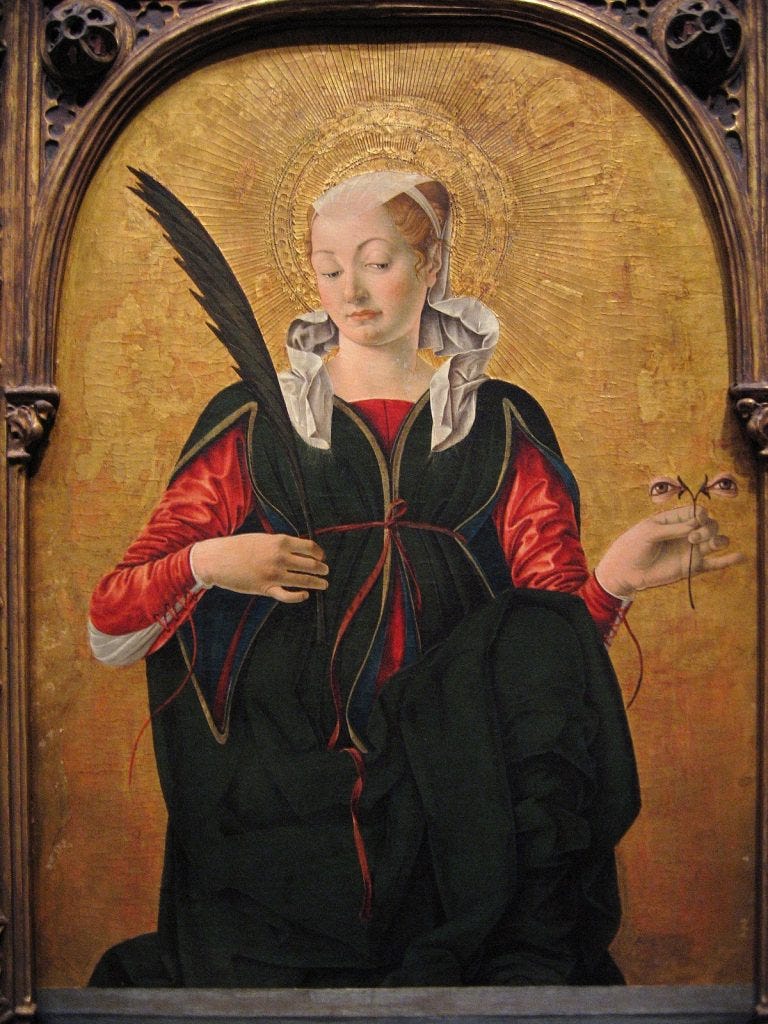My first exposure to the Swedish Lucia was in childhood. I had possession of an American Girl Doll, whose story was that of a Swedish immigrant named Kirsten Larson. I chose her because she had blonde braids and blue eyes, and I thought she was beautiful.
Unbeknownst to me, this shallow decision was the spark which would ignite my curiosity about all things Germanic -- in general -- and Norse -- in particular. For her Christmas story, Kirstin-doll received a white robe and red sash, complete with greenery wreath and saffron buns. As the eldest daughter of a Swedish household, Kirstin took the privileged role of Lucia, bringing hot coffee and fresh-baked pastries to her family one winter morning on what was, in the Julian calendar, the darkest day of the year.
The image of Saint Lucy, particularly as she is venerated by the Lutheran Swedes, was and is an icon to me, bearing forth the image of Christ across the vastness of Creation. It seemed to rise in me from some primordial waters of my deepest subconscious: the beautiful woman crowned with a wreath of light. One might say, I recognised her. Ever since, when Saint Lucy Day approaches, my entire being leans toward hers as if to say, "It's you! I've been waiting for you ..."
And we go to the Bridegroom together rejoicing.
As I grew older, I was delighted to find my various loves overlapping: my Catholic faith and its multitudinous saints, the liturgical year and its hopeless entanglement with the natural seasons, all things Scandinavian and Germanic (I am, like all Tolkien fans, an Anglophile). I developed as though following a blueprint etched into my genetic code; perhaps better said, by divine plan.
It is a mystery how Saint Lucia came to be so beloved in Lutheran Sweden. She is venerated still in Sicily, her homeland, and mentioned by name in the Canon of the Mass, one of seven women besides the Blessed Virgin Mary, no small honour indeed. Martyred during the reign of Diocletian for her faith, her apocryphal hagiography tells how her eyes were plucked out, either by herself or her persecutors. This is considered legend.
I do not take legends lightly. They are, after all, stories, and like stories, they communicate complex, transcendental truths to human beings, who make sense of the world around them through symbols. Eyes are the organs by which we see light. Lucy means "light." There are no coincidences.
To me, Lucy's sightlessness stands as an outward sign of an inward reality: the eternal, unbegotten Light by which she saw, and which lit up her very being. The folk legend in Sweden is that when a community living lakeside in the bitter winter suffered from famine, a beautiful maiden crowned with lit candles crossed to them in a boat, bearing them food to stave off despair. Some conjecture the Swedish Lucy may be syncretised with a pre-Christian goddess, who would have been supplicated around the time of the winter solstice, which just happened to fall on the 13th of December on the Julian calendar -- Saint Lucy's Day.
I believe this story is truer than true. I think that the dark despair which besieged the Swedes was both literal and spiritual. That they were evangelized by the efforts of missionaries, who, like Lucy, carried the light of Christ with them into the far corners of the world. I believe Lucy came to them, in one form or another, in or out of time, factually or figuratively, to hearten the children of God and promise the return of Light. I believe that when the ancient Pagan peoples saw Lucia, the little maiden martyr born to them by pious Italians in stories and pictures, they recognised her, just as I did. That the people of Sweden heard and saw and said, "It's you. We've been waiting for you ..."
May we all greet the Christ Child the same, in his first, second, and third comings, this Christmastide and always.
+JMJ+







Last week while we were visiting my in-laws my husband saw in passing a sign outside a Lutheran church for a swedish Christmas market. We went and they did the whole Sankta Lucia shebang - little girls in white dresses, boys with star-spangled pointy hats, Swedish Christmas caroling...it was MAGICAL. Floating around my parents' house is a St. Lucy doll from my own childhood- a little waldorf-style doll with mohair braids and a little candle crown–and it's time to haul her out!
Christie, have you read Gertrud Mueller Nelson's "To Dance With God"? The section on St. Nicholas makes a point that is so resonant with what you're beautifully saying here - that in the modern day, we tend to equate "myth" with "lie." Like you, I take legends seriously! Thanks for this wonderful reflection on one of my favorite saints.